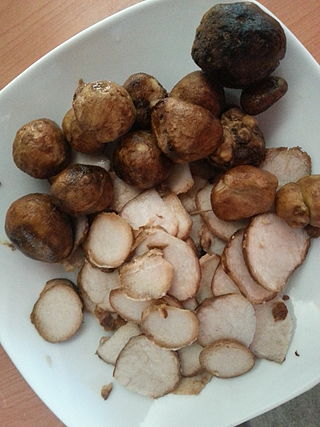Top Qs
Timeline
Chat
Perspective
Kalaharituber
Single-species genus of fungi From Wikipedia, the free encyclopedia
Remove ads
Kalaharituber is a fungal genus in the family Pezizaceae.[1] It is a monotypic genus, whose single truffle-like species, Kalaharituber pfeilii, is found in the Kalahari Desert, which spans the larger part of Botswana, the east of Namibia and the Northern Cape Province of South Africa.[2][3][4]
Remove ads
Taxonomy
The fungus was first described scientifically in 1895 by German mycologist Paul Christoph Hennings as Terfezia pfeilii.[5] It was moved to its own genus in 2005 by James Trappe and Varda Kagan-Zur.[6]
Description
Fruiting bodies can be up to 12 centimetres (4+3⁄4 in) in diameter. These weigh approximately 200 grams (7 oz), although larger rains (which affect weight) can cause them to weigh twice as much.[2] These fruits grow close to the surface, which causes surface cracks on the ground above[3][7] after rains. These fruiting bodies can occur as much as 40 cm away from the main hyphae.[7]
Remove ads
Habitat
Kalaharituber pfeilii is found the Kalahari Desert, as well as in other arid regions of South Africa, Angola, Botswana and Namibia. It is found in soils with a pH ranging from 5.5 to 6.5, with a sand content varying from 94%-97%, a clay content varying from 2%-5% and a silt content varying from 1%-4%.[7]
Ecology
Kalaharituber pfeilii is known to form an ectomycorrhizal relationship with Citrillus lanatus (watermelon), and is suspected to have a number of other possible relationships with other plant species. These include Sorghum bicolor, Eragrostis spp., Grewia flava,[3][4] several species of acacia,[7] and Cynodon dactylon.[3]
It is eaten by meerkats, hyenas, baboons and bat-eared foxes.[2]
Conservation
The current populations of K. pfeilii are thought to be in deterioration, with possible causes advanced being over-harvesting, climate change or the land practices used in K. pfeilii habitats.[3][4]
Edibility
Kalaharituber pfeilii is eaten by humans.[2] According to a case study by the Australian National Botanic Gardens, the fruiting body is eaten by the Khoisan and other indigenous peoples of the Kalahari. Some commercial use of the species occurs.[2]
References
Wikiwand - on
Seamless Wikipedia browsing. On steroids.
Remove ads

